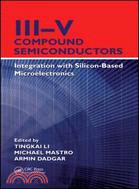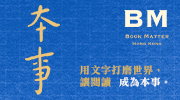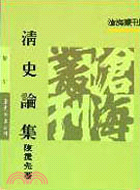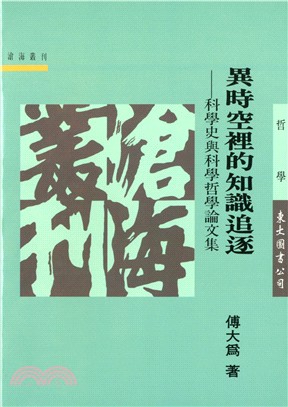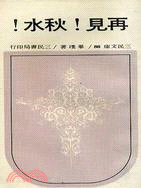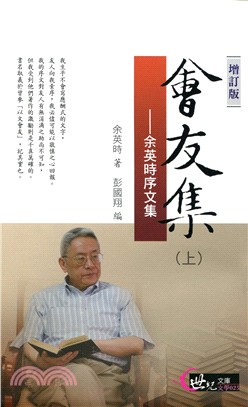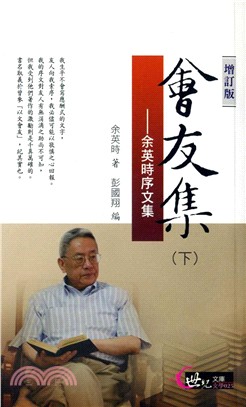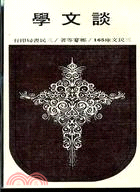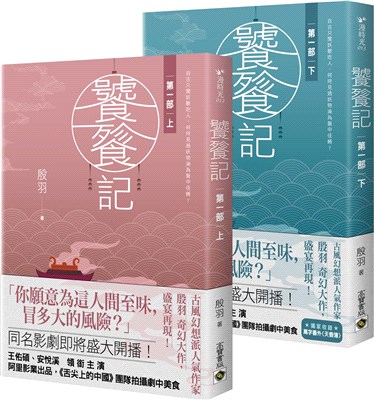III-V Compound Semiconductors: Integration With Silicon-Based Microelectronics
商品資訊
ISBN13:9781439815229
出版社:CRC Press UK
作者:Tingkai Li (EDT); Michael Mastro (EDT); Armin Dadgar (EDT)
出版日:2010/12/02
裝訂/頁數:平裝/603頁
定價
:NT$ 14300 元優惠價
:90 折 12870 元
若需訂購本書,請電洽客服 02-25006600[分機130、131]。
商品簡介
作者簡介
目次
相關商品
商品簡介
Silicon-based microelectronics has steadily improved in various performance-to-cost metrics. But after decades of processor scaling, fundamental limitations and considerable new challenges have emerged. The integration of compound semiconductors is the leading candidate to address many of these issues and to continue the relentless pursuit of more powerful, cost-effective processors.
III-V Compound Semiconductors: Integration with Silicon-Based Microelectronics covers recent progress in this area, addressing the two major revolutions occurring in the semiconductor industry: integration of compound semiconductors into Si microelectronics, and their fabrication on large-area Si substrates. The authors present a scientific and technological exploration of GaN, GaAs, and III-V compound semiconductor devices within Si microelectronics, building a fundamental foundation to help readers deal with relevant design and application issues.
Explores silicon-based CMOS applications developed within the cutting-edge DARPA program
Providing an overview of systems, devices, and their component materials, this book:
Describes structure, phase diagrams, and physical and chemical properties of III-V and Si materials, as well as integration challenges
Focuses on the key merits of GaN, including its importance in commercializing a new class of power diodes and transistors
Analyzes more traditional III-V materials, discussing their merits and drawbacks for device integration with Si microelectronics
Elucidates properties of III-V semiconductors and describes approaches to evaluate and characterize their attributes
Introduces novel technologies for the measurement and evaluation of material quality and device properties
Investigates state-of-the-art optical devices, LEDs, Si photonics, high-speed, high-power III-V materials and devices, III-V solar cell devices, and more
Assembling the work of renowned experts, this is a reference for scientists and engineers working at the intersection of Si and compound semiconductor technology. Its comprehensive coverage is valuable for both students and experts in this burgeoning field.
III-V Compound Semiconductors: Integration with Silicon-Based Microelectronics covers recent progress in this area, addressing the two major revolutions occurring in the semiconductor industry: integration of compound semiconductors into Si microelectronics, and their fabrication on large-area Si substrates. The authors present a scientific and technological exploration of GaN, GaAs, and III-V compound semiconductor devices within Si microelectronics, building a fundamental foundation to help readers deal with relevant design and application issues.
Explores silicon-based CMOS applications developed within the cutting-edge DARPA program
Providing an overview of systems, devices, and their component materials, this book:
Describes structure, phase diagrams, and physical and chemical properties of III-V and Si materials, as well as integration challenges
Focuses on the key merits of GaN, including its importance in commercializing a new class of power diodes and transistors
Analyzes more traditional III-V materials, discussing their merits and drawbacks for device integration with Si microelectronics
Elucidates properties of III-V semiconductors and describes approaches to evaluate and characterize their attributes
Introduces novel technologies for the measurement and evaluation of material quality and device properties
Investigates state-of-the-art optical devices, LEDs, Si photonics, high-speed, high-power III-V materials and devices, III-V solar cell devices, and more
Assembling the work of renowned experts, this is a reference for scientists and engineers working at the intersection of Si and compound semiconductor technology. Its comprehensive coverage is valuable for both students and experts in this burgeoning field.
作者簡介
Tingkai Li, Ph.D., is currently working at Micron Technology, Inc. as a senior technical member. He published over 100 technical papers, edited three preceding books, and was granted 93 US patents and many awards related in semiconductor and compound semiconductor device and materials research. He is an invited paper reviewer of the Applied Physics Letter, Journal of Applied Physics, IEEE Electron Device Letter, IEEE Transaction of Electron Device, etc., and overseas editor of Journal of Inorganic Materials. He is also honorary professor at Hunan University, Wuhan University of Technologies, and Zhejiang University in China. Dr. Li received a Ph.D. degree in Materials Science and Engineering from Zhejiang University, P. R. China, in 1987, and was a postdoctoral fellow and research scientist at Virginia Polytechnic Institute and State University, Blacksburg, Virginia from 1989-1995. From 1995-1998, he worked as a Staff Scientist in EMCORE Cooperation, New Jersey. He joined Sharp Laboratories in 1998 as a principal member of technical staff and project manager.
Michael Mastro, currently a civilian staff scientist at the U.S. Naval Research Lab, has more than 10 years of research experience in thin film growth and characterization, as well as semiconductor device design and nano-fabrication. This includes a number of fundamental advances in the fabrication of planar LEDs and high-power electronic devices, in addition to the development of novel nano-devices, which has resulted in authorship on more than 100 papers and patents. Michael earned a Ph.D. from the University of Florida in 2001 and a B.S. in Chemical Engineering from the Johns Hopkins University in 1997.
Armin Dadgar studied physics at University of Heidelberg and at TU-Berlin, where he received his doctor of natural sciences in 1999, successfully developing an alternative method to Fe doping to obtain semiinsulating InP by using Ru. Since 1999 has worked at the Otto-von-Guericke-Universitaet Magdeburg in the group of Prof. Alois Krost and is private lecturer since 2005. There he developed methods to grow thick crack-free GaN on Si by MOVPE in 2000 and demonstrated the first thick crack-free GaN LED grown by a patterning method in 2001 followed by the first thick crack-free LED on planar silicon substrate shortly after. In 2003 he co-founded AZZURRO Semiconductors AG and held the CTO position until he left the company in 2009. During his time at AZZURRO he demonstrated the first GaN-on-Silicon on 150 mm substrates in 2005, high voltage GaN on Si FETs up to 1800 V breakdown voltage and successfully transferred an LED buffer growth process to OSRAM Opto Semiconductors in 2008/2009. He is author of more than 150 papers, co-inventor of more than 30 patents or patent applications in the field of semiconductors, and received several national awards for his pioneering work on GaN-on-Silicon.
Michael Mastro, currently a civilian staff scientist at the U.S. Naval Research Lab, has more than 10 years of research experience in thin film growth and characterization, as well as semiconductor device design and nano-fabrication. This includes a number of fundamental advances in the fabrication of planar LEDs and high-power electronic devices, in addition to the development of novel nano-devices, which has resulted in authorship on more than 100 papers and patents. Michael earned a Ph.D. from the University of Florida in 2001 and a B.S. in Chemical Engineering from the Johns Hopkins University in 1997.
Armin Dadgar studied physics at University of Heidelberg and at TU-Berlin, where he received his doctor of natural sciences in 1999, successfully developing an alternative method to Fe doping to obtain semiinsulating InP by using Ru. Since 1999 has worked at the Otto-von-Guericke-Universitaet Magdeburg in the group of Prof. Alois Krost and is private lecturer since 2005. There he developed methods to grow thick crack-free GaN on Si by MOVPE in 2000 and demonstrated the first thick crack-free GaN LED grown by a patterning method in 2001 followed by the first thick crack-free LED on planar silicon substrate shortly after. In 2003 he co-founded AZZURRO Semiconductors AG and held the CTO position until he left the company in 2009. During his time at AZZURRO he demonstrated the first GaN-on-Silicon on 150 mm substrates in 2005, high voltage GaN on Si FETs up to 1800 V breakdown voltage and successfully transferred an LED buffer growth process to OSRAM Opto Semiconductors in 2008/2009. He is author of more than 150 papers, co-inventor of more than 30 patents or patent applications in the field of semiconductors, and received several national awards for his pioneering work on GaN-on-Silicon.
目次
Part I: Basic Physical and Chemical Properties
Fundamentals and the Future of Semiconductor Device Technology, M. Mastro
The Challenge of III–V Materials Integration with Si Microelectronics, T. Li
Part II: GaN and Related Alloys on Silicon Growth and Integration Techniques
III-Nitrides on Si Substrate, J. Li, J.Y. Lin, H. Jiang, and N. Sawaki
New Technology Approaches, A. Dadgar
Part III: III–V Materials and Device Integration Processes with Si Microelectronics
Group III-A Nitrides on Si: Stress and Microstructural Evolution, S. Raghavan and J.M. Redwing
Direct Growth of III–V Devices on Silicon, T. Kazior, K.J. Herrick, and J. LaRoche
Optoelectronic Device Integrated on Si, Di Liang and J.E. Bowers
Reliability of III–V Electronic Devices, A.A. Immorlica, Jr.
Part IV: Defect and Properties Evaluation and Characterization
In Situ Curvature Measurements, Strains, and Stresses in the Case of Large Wafer Bending and Multilayer Systems, R. Clos and A. Krost
X-Ray Characterization of Group III-Nitrides, A. Krost and J. Bläsing
Luminescence in GaN, F. Bertram
Part V: Device Structures and Properties
GaN-Based Optical Devices on Silicon, A. Dadgar
The Conventional III–V Materials and Devices on Silicon, E.Y. Chang
III–V Solar Cells on Silicon, S.A. Ringel and T.J. Grassman
Fundamentals and the Future of Semiconductor Device Technology, M. Mastro
The Challenge of III–V Materials Integration with Si Microelectronics, T. Li
Part II: GaN and Related Alloys on Silicon Growth and Integration Techniques
III-Nitrides on Si Substrate, J. Li, J.Y. Lin, H. Jiang, and N. Sawaki
New Technology Approaches, A. Dadgar
Part III: III–V Materials and Device Integration Processes with Si Microelectronics
Group III-A Nitrides on Si: Stress and Microstructural Evolution, S. Raghavan and J.M. Redwing
Direct Growth of III–V Devices on Silicon, T. Kazior, K.J. Herrick, and J. LaRoche
Optoelectronic Device Integrated on Si, Di Liang and J.E. Bowers
Reliability of III–V Electronic Devices, A.A. Immorlica, Jr.
Part IV: Defect and Properties Evaluation and Characterization
In Situ Curvature Measurements, Strains, and Stresses in the Case of Large Wafer Bending and Multilayer Systems, R. Clos and A. Krost
X-Ray Characterization of Group III-Nitrides, A. Krost and J. Bläsing
Luminescence in GaN, F. Bertram
Part V: Device Structures and Properties
GaN-Based Optical Devices on Silicon, A. Dadgar
The Conventional III–V Materials and Devices on Silicon, E.Y. Chang
III–V Solar Cells on Silicon, S.A. Ringel and T.J. Grassman
主題書展
更多
主題書展
更多書展今日66折
您曾經瀏覽過的商品
購物須知
外文書商品之書封,為出版社提供之樣本。實際出貨商品,以出版社所提供之現有版本為主。部份書籍,因出版社供應狀況特殊,匯率將依實際狀況做調整。
無庫存之商品,在您完成訂單程序之後,將以空運的方式為你下單調貨。為了縮短等待的時間,建議您將外文書與其他商品分開下單,以獲得最快的取貨速度,平均調貨時間為1~2個月。
為了保護您的權益,「三民網路書店」提供會員七日商品鑑賞期(收到商品為起始日)。
若要辦理退貨,請在商品鑑賞期內寄回,且商品必須是全新狀態與完整包裝(商品、附件、發票、隨貨贈品等)否則恕不接受退貨。



